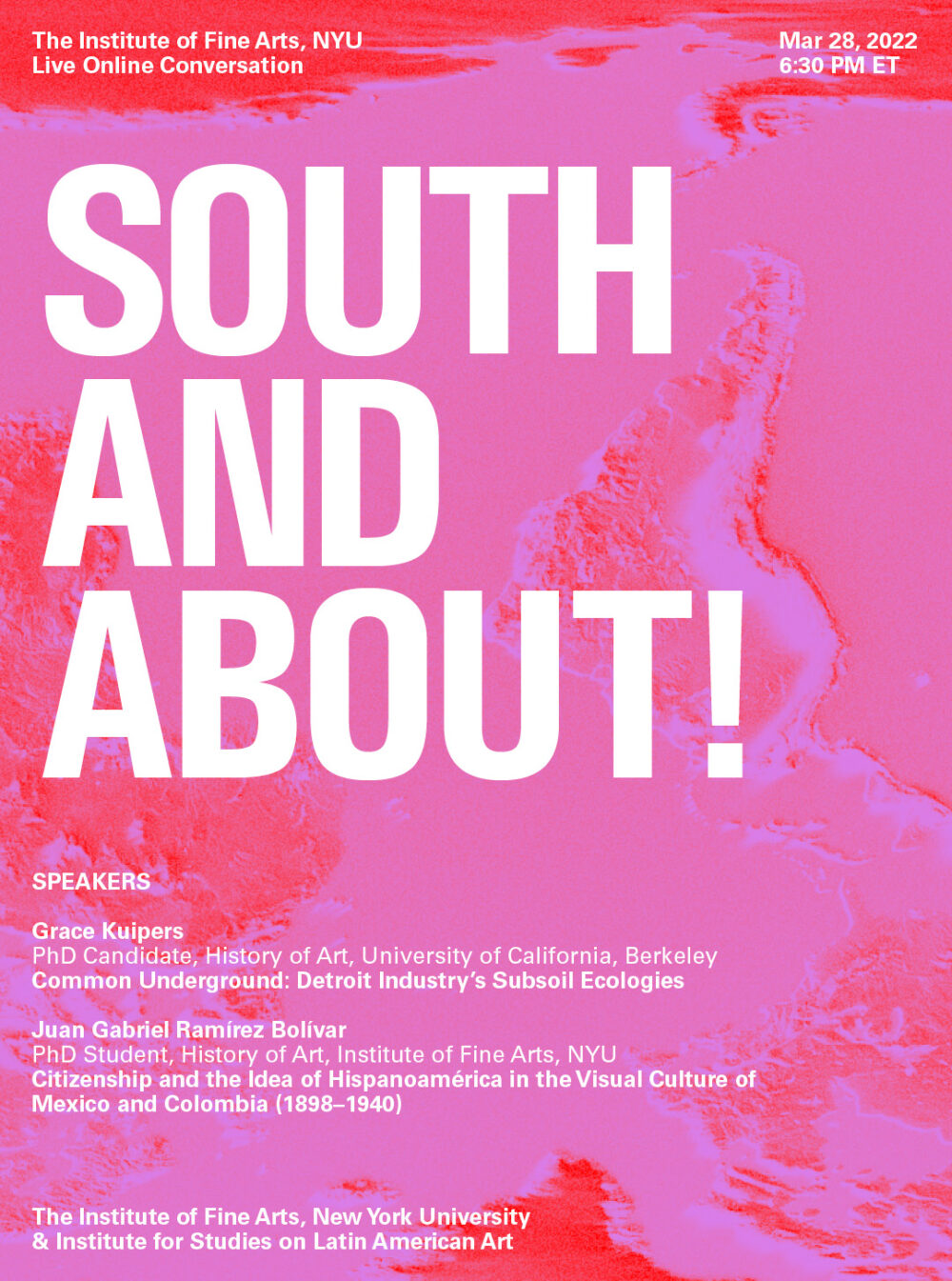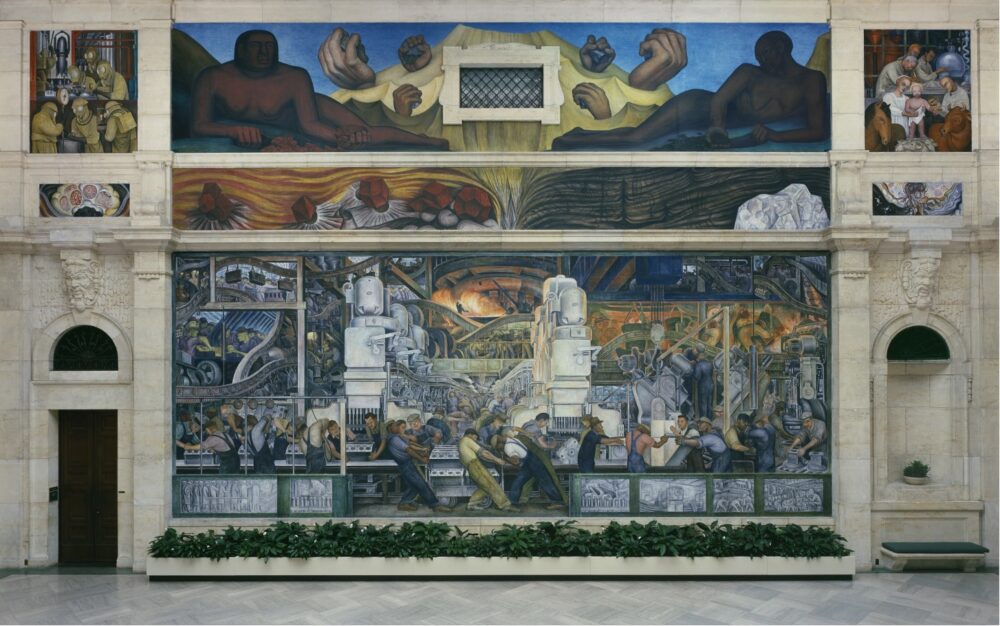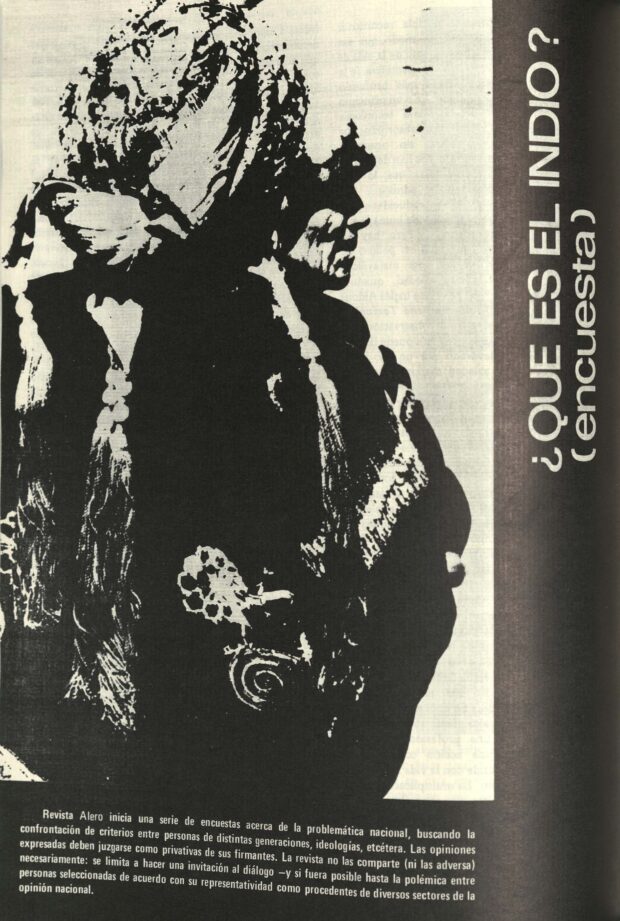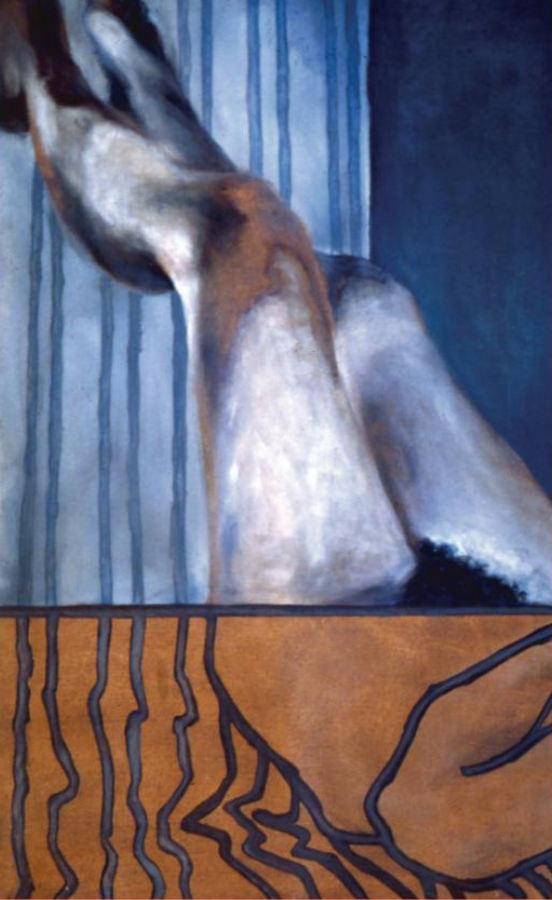South and About! Spring 2022
March 28, 2022
South & About! is a student-organized research workshop on the arts from Latin America and the Caribbean. This program invites graduate students and emerging scholars in art history and related disciplines to participate in informal discussions amongst their peers.
Common Underground: Detroit Industry’s Subsoil Ecologies
Grace Kuipers, PhD Candidate, History of Art, University of California, Berkeley
While frequently discussed as a paean to the advanced machinery at Ford’s River Rouge motor complex, Diego Rivera’s Detroit Industry raises just as many questions about the subterranean minerals that sustain that machinery. Geological matter occupies a commanding position, represented in stratigraphic cross-sections, anthropomorphic nudes, and even as the basis for life itself. Curiously, these minerals are also placed within a distinctly continental geography: while the series supposedly represents Detroit’s local industry, minerals emerge in clenched fists from the stepped pyramids and volcanoes of Mexico’s central valley. What are we to make of this binational ecosystem?
This paper examines Detroit Industry as a response to the U.S. mineral frontier, which positioned North America’s underground as borderless in order to contest Mexico’s campaign to nationalize its subsoil. I argue that, while Detroit Industry obliged the image of a borderless underground, it troubled the capitalist epistemologies of the U.S. mineral frontier. I contextualize Rivera’s mineral-oriented muralism by examining his commitment to Indigenous, community-stewarded mines and the ejido system, analyzing Detroit Industry alongside his fresco series at Chapingo, whose enormous program was oriented almost entirely around the post-revolutionary goal of the ejido system. Rather than render the underground as an inert “storehouse” of abstract values for human exploitation, Rivera positions the subsoil as part of a holistic, living ecosystem, inclusive of politics and with interdependent links to racial and economic equality.
Citizenship and the Idea of Hispanoamérica in the Visual Culture of Mexico and Colombia (1898–1940)
Juan Gabriel Ramírez Bolívar, PhD Student, History of Art, Institute of Fine Arts, NYU
The point of departure for this dissertation proposal comes from common ideas displayed in two artworks from Mexico and Colombia respectively. The mural painting La Unión de América Latina made in 1924, by the Mexican artist Roberto Montenegro (1885-1968), and La Apotéosis de Popayán, made between 1935 and 1956 by the Colombian Efraim Martínez (1898-1956) represent idealized images of harmonious and homogenous cultures that resulted after the colonial dominance of the Spanish empire. These scenes contrast with the social and political tensions that characterized these two societies in the nineteenth and early twentieth centuries, a time marked by restricted conceptions of citizenship based on gender, class, and race. By taking these artworks as starting point, the dissertation will analyze images presenting political ideas about citizenship in Mexico and Colombia between 1898 and 1940. This research will examine pictures of citizenship that appeared in murals, literary magazines, prints, and newspapers circulating in these two countries. The examination of networks and artistic exchanges between artists and writers will allow a broader understanding of the politics of representation of citizenship and the tensions that resulted in the exercise of it for different sectors of these two societies. While considering the essential role of public opinion and public spheres in the construction of citizenship, the project also investigates the ways in which the artistic practices of women, workers, artisans (obreros y artesanos), as well indigenous peoples could be seen as political expressions in the public sphere at the beginning of the twentieth century. At the same time, the research will show the decisive role and influence of the political idea of Hispanoamérica in the consolidation of a citizenry in both countries. Through this analysis, it will be possible to understand the limits of representation and the tensions in the access to citizenship that certain members of these societies had at the beginning of the twentieth century.
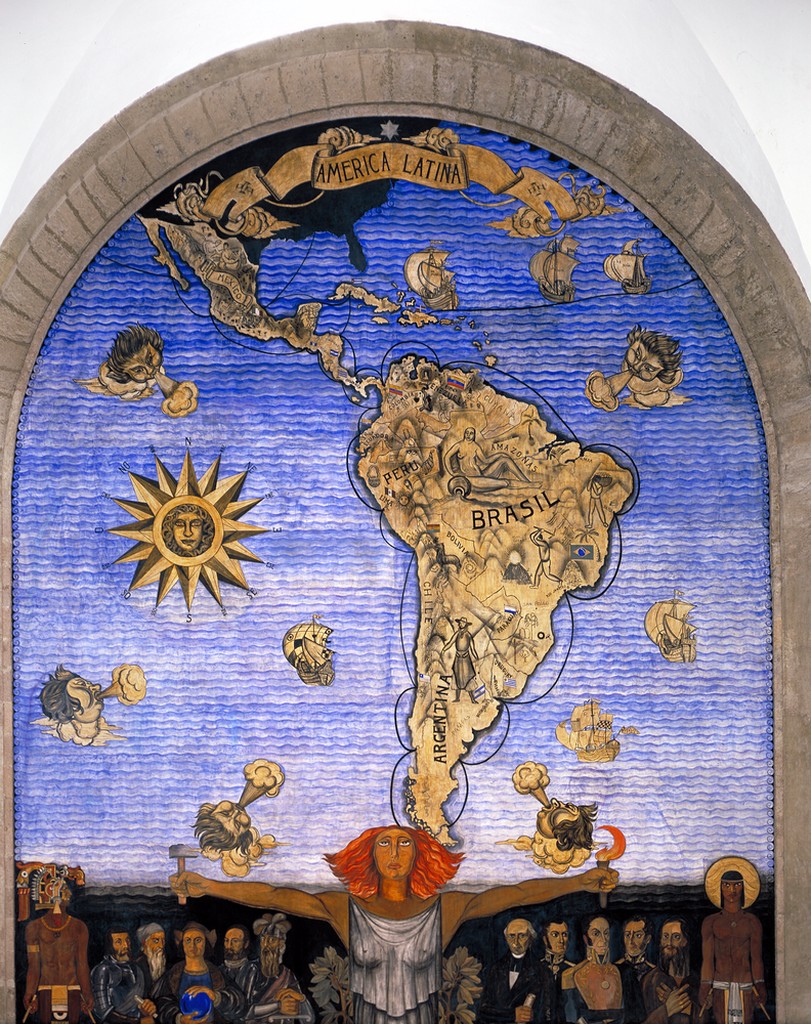
February 7
South & About! is a student-organized research workshop on the arts from Latin America and the Caribbean. This program invites graduate students and emerging scholars in art history and related disciplines to participate in informal discussions amongst their peers.
“¿Qué es el Indio?”: Indigenismo and Photography in Guatemalan Print Culture
Adriana Obiols, PhD student, Art History, University of Chicago
Revista Alero was a magazine published between 1970 and 1980 by a group of artists and intellectuals affiliated with the Universidad de San Carlos de Guatemala. My research investigates the relationship between the cultural and political programme of Alero and the particular vision of the Guatemalan nation that intellectuals affiliated with the University of San Carlos developed during the twentieth century, which historian Heather Vrana has defined in her work on Guatemalan “student nationalism.”1 I argue that, through its many phases, Alero employed visual strategies including photography, photomanipulation, and photomontage in order to validate and give force to these intellectuals’ vision of the nation.
This essay centers on the photographic representation of indigenous people in Alero. I place these images in conversation with developments in indigenista scholarship as well as with preceding models for the imaging of indigeneity in Guatemala. I argue, first, that photographs in Alero challenged previous visual models by foreclosing access to ethnographic details and by emphasizing the arduousness of agricultural labor. Alero presented images of indigenous people in aesthetically innovative ways, displaying a clear interest in abstraction and formal play, and including them in vanguardist forms such as photomontages. At the same time, these photographs were conditioned by the intellectual environment they emerged from and therefore conformed to the very specific understanding of indigeneity that indigenista scholars developed at this time. Images that made visible those aspects that the indigenistas considered inherent to indigeneity – poverty, especially, and its roots in the country’s economic dependency – thus granted credibility and power to USAC social scientists’ vision of the nation’s ethnic, social, and economic character.
1 Vrana, Heather. This City Belongs to You: A History of Student Activism in Guatemala, 1944-1996. California: University of California Press, 2017.
Toward Feminist Poetics in Central America: Articulations of Desire in the Work of Patricia Belli
Lesdi C. Goussen Robleto, PhD candidate, History of Art, University of California, Berkeley
This talk foreshadows the first chapter of my dissertation, “(Un)Mending Bodies: Patricia Belli and Feminist Artistic Praxis in Central America, 1986-2000s,” by situating Patricia Belli’s return to Nicaragua in 1987, amidst the ongoing U.S-backed Contra War and feminist tensions in the public sphere. Tending to shifts within her practice, I consider how Belli’s return is marked by formal and thematic transitions between painting and writing that foreground a dialogic relationship between body and text. Going against the ethos of the Sandinista revolution and the entanglements between masculinist literature and nationalistic painting traditions that had emerged in the preceding decades, Belli introduces a highly charged visual and textural language that unravels revolutionary aesthetics by challenging mediums of official memory. By mobilizing a series of short stories alongside drawings and paintings during this period, this talk explores the ways in which the erotic becomes a counter-revolutionary instrument for self-determination that takes shape along the textures of the body within the everyday, revealing the liminal and intimate spaces in domestic life that create apertures for pleasure and experimentation by disrupting normative structures and behavioral codes. These openings are also marked by somatics of pain and processes of healing that are rooted in mechanisms of the body, and most specifically articulated through epidermic surfaces and allusions to textile. Taking these dialogic threads as my point of departure, I am interested in how Belli’s works align with rising feminist discourses and literary practices in Nicaragua, including the emergence of autonomous feminist groups, such as the “Partido de la Izquierda Erótica” (Party of the Erotic Left, PIE) in the late 1980s, which challenged the masculinist discourse of the Sandinista National Liberation Front (FSLN) by foregrounding women as agents of their own bodies and political agendas. These efforts pay homage to earlier feminist practices in the region by citing the Guatemalan poet, Ana María Rodas, whose work Poemas de la Izquierda Erotica directly influences the emergence of PIE.1 Through Belli’s interventions between painting and literature, text and the body, and feminine and feminist forms, I also begin to explore the centrality of (text)iles in her work, as it becomes entangled with the work of other Central American women artists mobilizing feminist poetics at the intersections of the body, text, and textiles.
1 Miguel A. López, “Patricia Belli and the Political Alchemy of The Body: Art and Feminism Between Revolution and Neoliberalism,” in Patricia Belli: Equilibrio y Colapso (San José, Costa Rica: TEOR/ética, 2018), 36.
